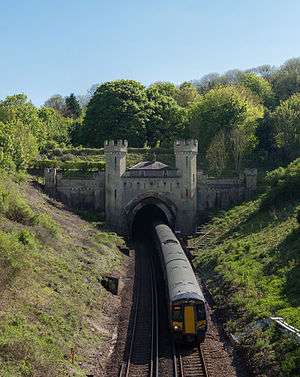Clayton Tunnel
Clayton Tunnel is a railway tunnel located in the village of Pyecombe near the village of Clayton, West Sussex between Hassocks and Preston Park railway stations on the Brighton Main Line. This tunnel is notable for its turreted and castellated north portal with a single-storey cottage on the top, and for being the site of a serious accident in 1861 which was influential in the adoption of a robust signalling system in the UK and elsewhere.

Another tunnel of the same name is found on the Queensbury Lines, a disused route between Queensbury and Bradford at 53.7763°N 1.8314°W.
At 1 mile 499 yards (2,066 m)[1] the Sussex Clayton Tunnel is the longest tunnel on the route. The tunnel [2] was designed by David Mocatta, architect to the London, Brighton and South Coast Railway. It was completed in 1841 after 3 years of work.
North Portal
The turreted and castellated north portal, along with its attached cottage (private dwelling) perched directly over the line, is one of the more unusual and photogenic railway features on the London-Brighton Main Line or in Sussex and is now a Grade II listed building.[3] It was clearly designed by Mocatta as it shares features with his Ouse Valley Viaduct. The portal was ornamented as a condition of the farmer who owned the land. The single-storey cottage over the north portal, which is built in contrasting red brick and sits curiously off centre, was added in 1849 and was designed by John Urpeth Rastrick for the purpose of housing the lamp-lighter, who was tasked with relighting the gas lamps in the tunnel after passing trains snuffed them out.
The south portal of the tunnel is relatively unremarkable.
Accident
The West Sussex tunnel was the site of an early form of "automatic" signal invented by CF Whitworth. Far from being automatic in operation, this was merely a signal that was operated by the signalman on duty but that returned to 'danger' once the train had passed, by means of a treadle. Clayton Tunnel had such a signal at each end, and it was the failure of the signalman to ensure that the signal had returned to danger that led to the worst ever accident on that line on 25 August 1861.
Three trains left Brighton within a very short time. Having signalled one train correctly, the signalman at the southern portal manually returned the signal to danger too late for the second train, but was unaware that his attempts to alert its driver by waving a flag had been successful. The second train stopped well inside the tunnel, and as it was slowly reversing towards him he misunderstood a 'tunnel clear' message from the north box as indicating the second train had cleared the tunnel when it in fact referred to the first. He then allowed a third to enter and collide with the reversing second train with the loss of 23 lives and 176 injured.
External links
- Clayton Tunnel North Portal
- Clayton Tunnel on Trainspots
References
- Yonge, John (November 2008) [1994]. Jacobs, Gerald (ed.). Railway Track Diagrams 5: Southern & TfL (3rd ed.). Bradford on Avon: Trackmaps. map 15C. ISBN 978-0-9549866-4-3.CS1 maint: ref=harv (link)
- "SideTracked - Clayton Tunnel". Geocaching (mattd2k). 17 October 2011. Retrieved on 28 April 2015.
- "Clayton Tunnel North Portal Tunnel Cottage, Pyecombe". British Listed Buildings. 11 May 1983. Retrieved on 28 April 2015.